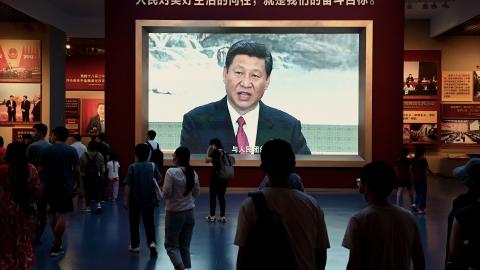Introduction
The first two policy memos in this series on Chinese information and influence warfare pointed out that the Chinese Communist Party (CCP) believes it is engaged in a perpetual “struggle” against the West and makes no fundamental distinction between wartime and peacetime. These reports also explained that the People’s Liberation Army (PLA) plays a central and often dominant role in leading doctrine and operations when it comes to informational and influence warfare.
Additionally, the previous memos argued that Asia and the Pacific are both the primary and most suitable subregions for the conduct of such Chinese activities. For the CCP and PLA, the region has unique material, geographical, ideational, and cultural characteristics that render it especially suitable for Beijing to successfully wage political warfare.
Previous memos focused on the PLA’s Three Warfares framework, which consists of public opinion, psychological, and legal warfare. The Chinese intent is not merely to disrupt, confuse, or create mischief but to craft and control grand narratives. Doing so is extremely effective because these narratives determine how we reflexively interpret information and situations, what seems possible or not, what seems prudent rather than reckless, and what appears to be rational and in one’s long-term interest. Grand narratives determine how we think about a problem, issue, or development. In doing so, they predetermine the range of “reasonable” options and solutions that we believe are available.
The previous memos also offered analysis and examples of how the CCP and PLA are using political warfare to achieve strategic objectives and to undermine the interests of the United States and its allies. Ominously, and in important respects, Beijing is not just “winning without fighting” but taking the more insidious approach of achieving strategic goals without victory.1
This third memo in the series examines US and allied information and influence doctrine and operations, especially by the defense establishments. In these democracies, the government has largely allowed the defense establishments to lead doctrine and capability for the information and influence elements of political warfare. The paper looks at the strengths and shortcomings of how the US and others conceive of information and influence warfare as it relates to responding to Chinese efforts in the region, as detailed in the first two memos. In doing so, it prepares the way for the fourth and final memo, which will look at specific policies and activities that the US and its allies could engage in to advance its interests and values and to counter some of the more damaging and insidious elements of Chinese political warfare in the region.
The memo focuses on the US and, to a lesser extent, Australia because these Five Eyes countries are the most active and invested in understanding and countering Chinese information and influencing warfare efforts in the region. It is important to remember that such warfare is different in nature, purpose, and implementation from the usual diplomatic and soft-power efforts undertaken by democracies. The first memo argues as follows:
Engaging in information and influence operations (or countering those by other countries) is a whole-of-government enterprise. [But it is] very different from the usual public messaging and soft power efforts led by diplomats and embassies. Engagement in this kind of political warfare is far more akin to missions undertaken by defense forces in that there must be specific objectives, tactics designed based on the objectives and resources available, and quick implementation by ready and well-resourced teams formed specifically for these tasks—even if this type of warfare is relentless and a protracted struggle.2



















